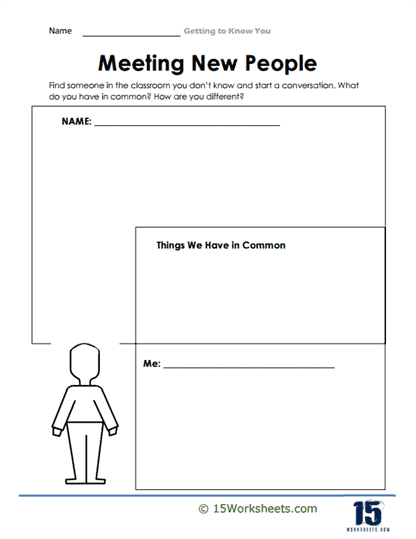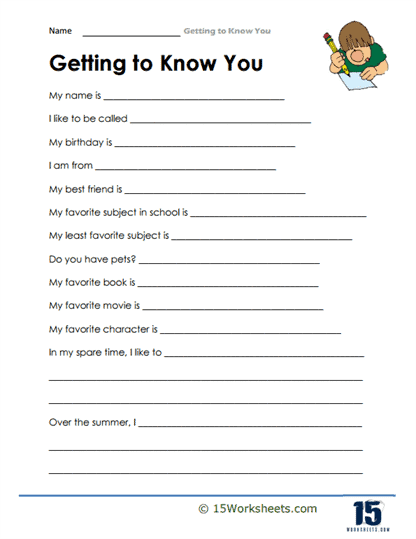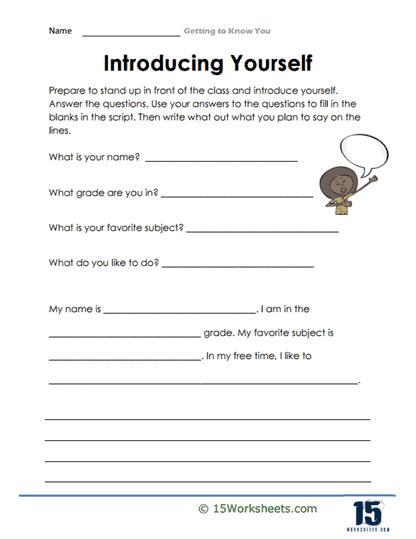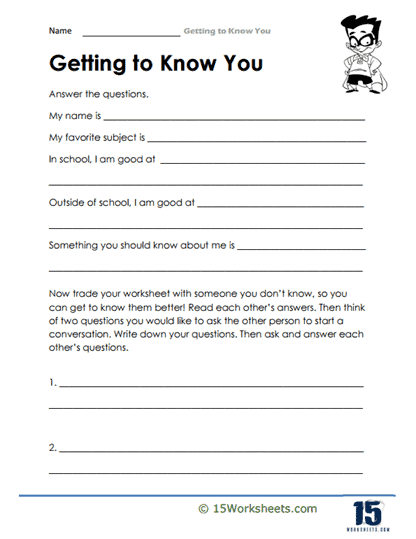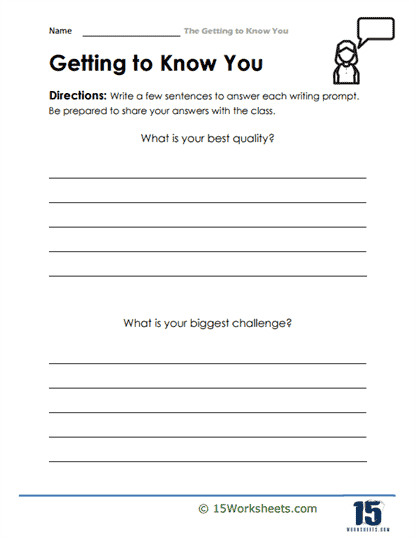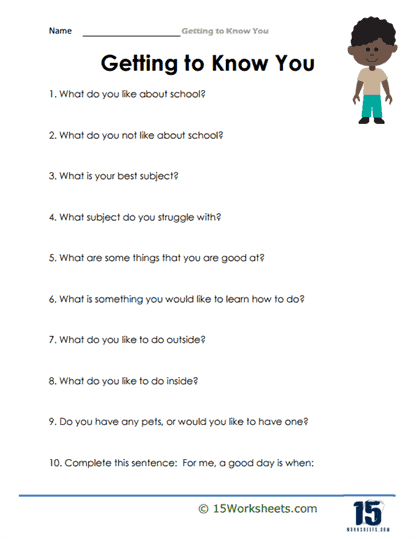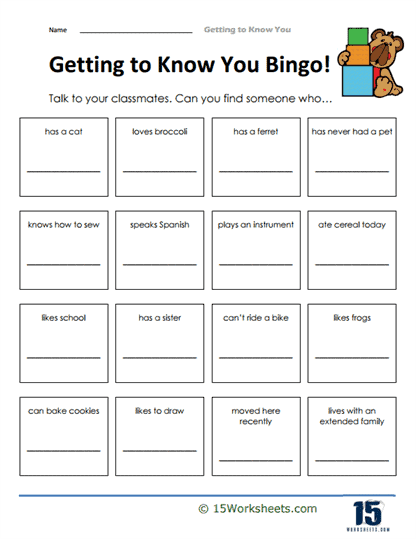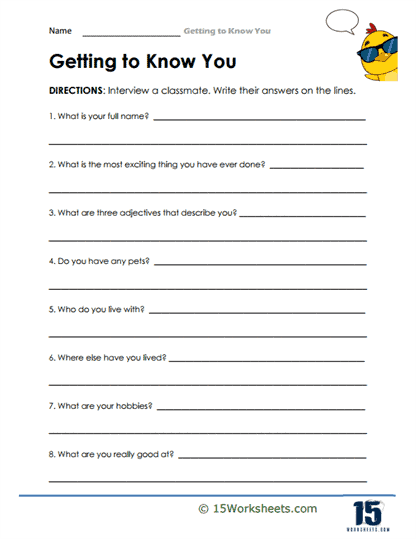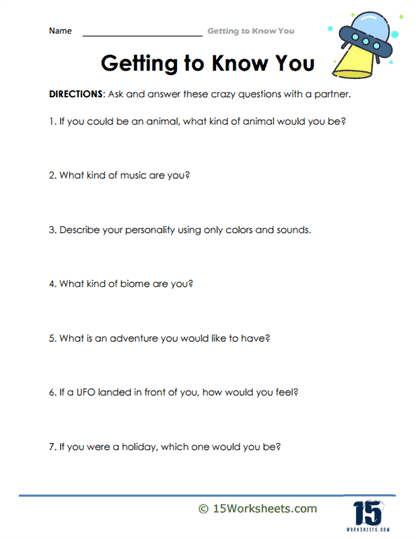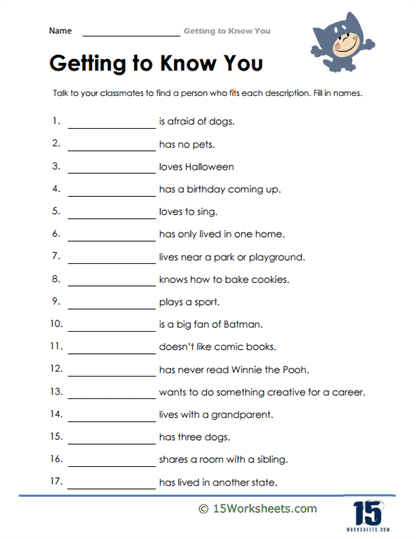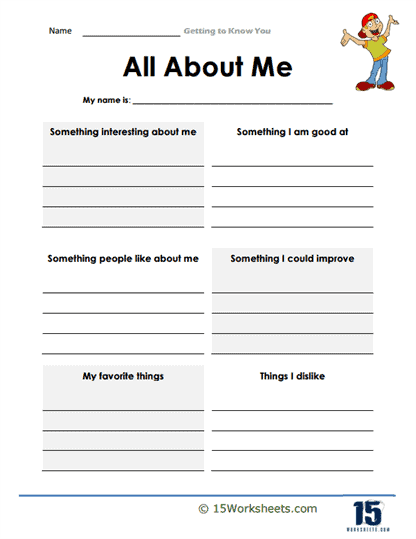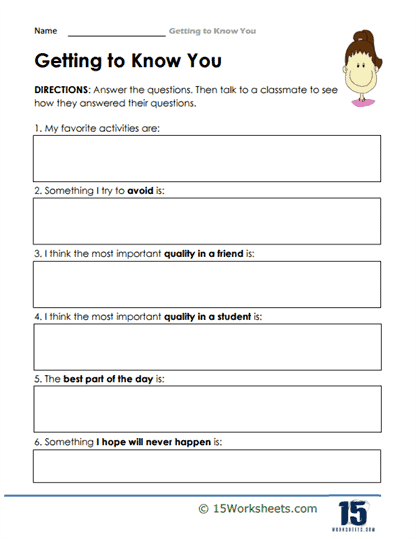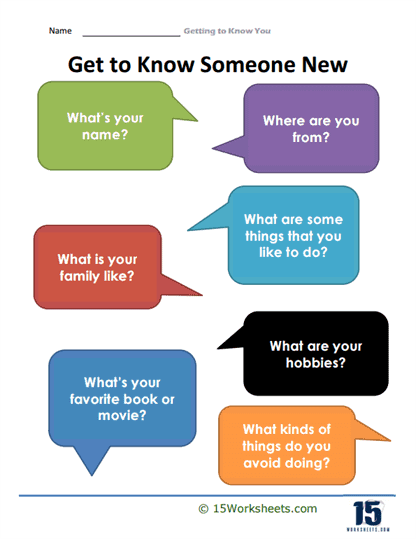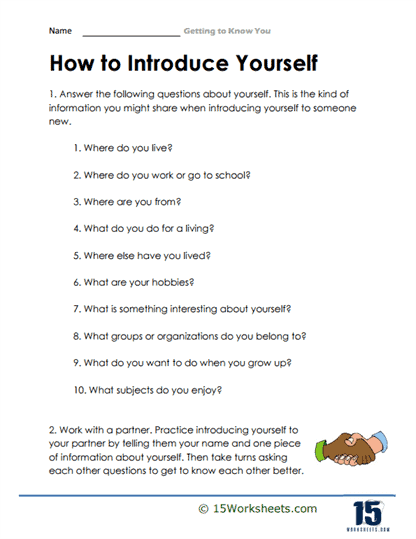Getting to Know You Worksheets
All About These 15 Worksheets
The journey of learning is one of the most profound and exciting experiences, especially for young children who are just beginning to explore the world around them. At the heart of this adventure is not just academic growth but also the development of social awareness and personal identity. As kindergarten students step into the classroom for the first time, they are not just introduced to letters, numbers, and shapes, but to the equally important world of human interaction, social skills, and self-discovery. This series of kindergarten worksheets, focused on “Getting to Know Each Other,” offers young learners an invaluable opportunity to navigate this new terrain.
These thoughtfully designed worksheets serve as a bridge between self-exploration and social interaction, allowing children to discover who they are while building meaningful relationships with their peers. The journey begins with simple exercises that introduce students to their classmates in a structured yet enjoyable way. As they share information about themselves and learn about others, they not only start to understand how they are similar to their peers but also appreciate the ways in which they are unique. This helps to foster a classroom environment that is rooted in empathy, understanding, and mutual respect.
One of the most critical aspects of early childhood development is the ability to express oneself, and these worksheets offer an excellent platform for children to do just that. Through activities like filling in sentence frames, students learn to articulate their thoughts and feelings. They practice simple phrases like, “My name is…” or “I like…” which may seem elementary, but these are the building blocks of effective communication. As they develop the language needed to talk about themselves, they also gain confidence in sharing their ideas in front of the class. Public speaking, even in its most basic form, can be intimidating for young learners, but by starting with introductions, students begin to build the self-assurance that will serve them in countless future social and academic situations.
Another critical component of these worksheets is the opportunity they provide for practicing empathy and active listening. When students learn how to ask questions to get to know others, they are doing much more than gathering information—they are learning to take an interest in someone else’s world. The ability to listen carefully and respond thoughtfully is a social skill that will benefit them for the rest of their lives. By engaging in these structured conversations, students develop a foundation of empathy that allows them to see the value in perspectives other than their own.
This bucket of worksheets encourage self-reflection, a skill that is often overlooked in early education. When students are prompted to answer questions about their preferences, qualities, and challenges, they begin the process of introspection. This is essential for building self-awareness, an understanding of their strengths and areas for growth. In a supportive classroom environment, these moments of self-reflection are not about competition or comparison but about personal growth. It is in this safe space that students can begin to appreciate themselves for who they are while recognizing that everyone has something unique to contribute.
The inclusion of interactive activities like a “Getting to Know You” Bingo game further enriches the learning experience. Such games offer a fun and engaging way for students to practice their new social skills in a low-pressure setting. As they move around the classroom asking questions and filling in their Bingo cards, students are actively participating in social interaction, making connections with their classmates in a manner that feels natural and playful. These seemingly simple activities are powerful tools for fostering an inclusive and cohesive classroom community.
Social-emotional development is a cornerstone of these worksheets, offering students the chance to explore their emotions, learn how to communicate effectively, and understand the importance of building relationships. By interacting with their peers in various ways—whether through asking questions, answering prompts, or participating in games—students gradually cultivate a sense of belonging. They come to see the classroom not just as a place for learning but as a community where everyone plays an important role.
The structured progression of these activities mirrors the developmental stages young learners go through as they begin to form their identities within the context of a group. At first, they may only see themselves as individuals with certain likes and dislikes, but as they engage more deeply with their peers, they start to understand the concept of community. They learn that while everyone has unique qualities, they are also part of something larger—the classroom family. This realization is an essential step toward fostering inclusion and a positive classroom culture, where every child feels valued and heard.
By providing hands-on exploration, these worksheets allow students to engage with their environment in a way that promotes critical thinking. As they reflect on their experiences, students begin to make connections between what they feel, how they act, and the impact those actions have on others. This encourages not only personal growth but also a deeper understanding of the social dynamics within their classroom.
In the broader context of education, these worksheets are laying the foundation for lifelong skills. Effective communication, empathy, self-awareness, and social interaction are not just important for academic success; they are vital for success in life. The ability to build strong, positive relationships, to express oneself clearly, and to understand others is crucial in any community, be it in school, at home, or in the workplace.
This series of worksheets serves as a stepping stone toward creating a classroom environment that is more than just a place for learning academic content. It becomes a nurturing space where young learners can grow emotionally, socially, and intellectually. The activities foster a sense of community, encouraging students to see the classroom as a place where they belong and where their contributions matter. In this way, the worksheets not only support individual development but also help to cultivate a classroom culture where mutual respect, empathy, and collaboration are at the core.
By the time students complete these exercises, they will have gained far more than just the ability to introduce themselves or ask a question. They will have begun to understand the complexities of human interaction, the importance of self-reflection, and the value of empathy. These lessons, though taught in a kindergarten classroom, are foundational skills that will serve them for years to come, helping to shape the kind of thoughtful, caring individuals they will grow into. Through these “Getting to Know You” worksheets, young learners embark on a journey that not only enhances their academic growth but also their personal and social development, preparing them for the rich, interconnected world that awaits them.
How to Help Teachers Get to Know Their Students
At the beginning of the school year, teachers should aim to get to know their students. This is important because it helps children become more invested in the subject they are learning and the overall school environment.
When we form strong connections with students, we can create an environment where learning and risk-taking are encouraged, and trust is taught.
1. Learn Names
Nothing is more basic and important than learning students’ names early in the year. Teachers should aim to learn the names of all students during the first week. This helps build a one-on-one relationship and helps students feel that their teacher values them.
Some strategies to encourage quick name learning include team building games, wearing name tags, playing name games, and using the student’s name frequently. Of course, you must practice and actively pay attention to each student’s name when you are referring to them.
2. Understand Goals
One way teachers can get to know their students is by sharing their social and academic goals for the upcoming year. Instead of only focusing on the students, teachers should share their own goals so that kids do not feel like they are talking to a stranger and can relate to the teacher.
As a teacher, you can make a bulletin board where every student can share his dream or goal. You can also get students to fill out a questionnaire that you can read at the end of class. This will help you understand your students and their dreams and aspirations.
The key is to actively listen to your students; some kids speak with hidden messages but expect adults to understand what they are saying. Hence, you must learn to read your student’s body language and really listen to what they are saying and implying. This will help you understand their personality, as well as their aspirations.
3. Understand their Background
It is important to understand the kind of families students come from and their backgrounds. This helps teachers feel more connected with their students and understand their personalities, triggers, and reactions.
Within the first few weeks of school, a teacher should aim to learn about every student’s background. While asking the child directly is a great idea, we would also recommend meeting the child’s parents to get an idea of what they are like and their hopes for their child. Do they expect too much from their kid? Are they too lenient? Does the child come from an abusive household? These are important details that you must know.
4. Be Accessible
There is no denying that teachers have a lot on their plate- whether this means planning in-class activities, dealing with tantrums, grading assignments, or preparing for the next day’s schedule. Despite all this, teachers must remain accessible to their students.
This could mean providing students with an email address you regularly check or giving them the freedom to text you if they ever need it. Not only does this help build trust amongst students, but it can also help you get to know them better. Knowing that an adult is there to listen to their troubles or help them with school homework is a blessing for which most children will be eternally thankful.

